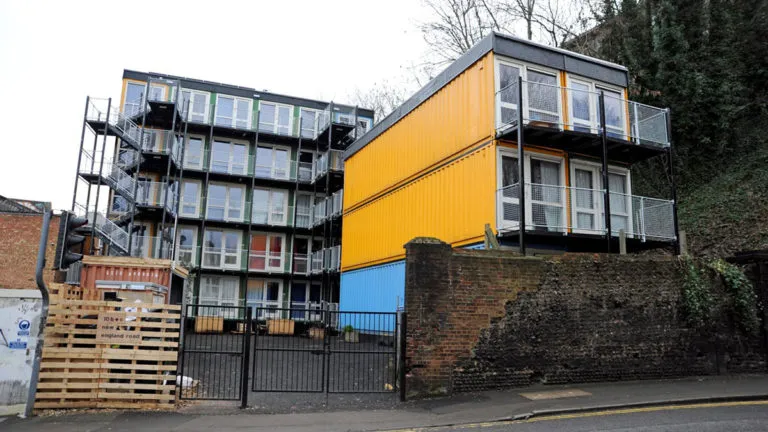We must call time on permitted development rights for new housing
Published: by Cecil Sagoe

Planning reform is on government’s agenda. The new Housing Secretary, Robert Jenrick, has said he’s interested in ‘ways in which we can further liberalise and improve the planning system’.
In the launch of our housing planning blog series last week, we set out why we want to see planning reforms that will deliver high-quality social housing at scale within well-planned neighbourhoods. However, we also outlined why planning reform in the form of deregulation is not the way forward.
Our planning blog series goes into more detail, setting out the case for proper planning and not deregulation, as well the alternative reforms we think will have a positive impact in tackling our housing crisis.
Below, we’ll discuss why planning deregulation in the form of extending permitted development rights (PDR) to deliver new housing is not a solution at all.
What are permitted development rights?
PDR provide an automatic, national grant of planning permission for certain classes of development. Schemes with PDR can therefore bypass the standard full, local planning process.
These are not a new feature of our planning system. Very small scale projects, such as some types of home extensions, have long been allowed under PDR.
However, over the last several years, government has introduced legislation that changed the game in terms of the types of development that have PDR. Since 2013, it has been possible to convert certain commercial buildings – most infamously including office blocks – into residential buildings using PDR. And since 2014, PDR has also covered the conversion of agricultural buildings into residential properties.
Currently, some close to government are making calls for the expansion of PDR. And government is now developing proposals to see PDR cover:
- upward extensions to deliver new homes
- potentially the demolition of commercial buildings to be rebuilt as housing
Government have been attracted to PDR as for them it delivers new units quickly, which add to the total delivered against their 300,000 new homes a year target. But at what price?
The problems with permitted development
As PDR schemes do not need to obtain planning permission, they do not need to comply with local planning policy and local authorities cannot enter into section 106 agreements with developers of these schemes. Neither can local authorities determine whether the scheme is of an acceptable quality to go ahead, or whether it is safe.
Instead, local authorities can only consider an extremely limited set of issues – such as flood risk and the impact of the scheme on highways – when deciding whether to give approval.
The consequences are now plain to see.
Local authorities have had no mechanism to secure social or affordable housing from PDR schemes. Last year, we indicated the devastating extent of this get out clause. We estimate that urban authorities have missed out on over 10,000 affordable homes between 2015–16 and 2017–18 as a result of housing schemes coming through the PDR route rather than through the conventional planning system. We have missed out on thousands of potential social homes at a time when nearly 277,000 people are recorded as homeless in England. This is nothing short of scandalous.
To make matters worse, the standards of some of the homes coming through this system are shocking. There have been reports of homes as small as 13 square metres being delivered. There are proposals coming forward for ‘oppressive’ PDR schemes, which will lack daylight and ventilation. There are also PDR schemes being delivered that have problems with fire safety.
Some of the worst schemes are being used as temporary accommodation for homeless households. Recent reports have highlighted that homeless familieis are living in overcrowded conditions in PDR schemes that are located on industrial estates far away from shops, schools and other essential amenities and services.
So, PDR is not just jeopardising the delivery of the high-quality social homes that we need to end our housing crisis, it is also adding fuel to the crisis by housing people in dangerous 21st century ‘slum’ housing.
Government must change tack
Earlier this year, government announced that it will review office-to-residential PDR conversions ‘in respect of the quality standard of homes delivered’.
This review is necessary, but it should not just be taking place with regards to office-to-residential conversions. It should be looking at all types of PDR that are leading to the delivery of new homes. Furthermore, government should also review the impact of PDR with respect to social housing delivery.
Our housing crisis will only be solved through the provision of high-quality social housing at scale. We estimate that three million more social homes are needed to solve the current crisis. That is why we are calling on the government to make policy, funding and legislative changes that will deliver a revolution in social house building.
Yes, planning reform has a role to play in this. But, as the Raynsford Review of Planning highlighted, we require reforms that will ensure the delivery of beautiful, safe and genuinely affordable homes that benefit communities in housing need.
In our next blogs, we discuss two of the alternative reforms that government can make to secure the high-quality social homes that we desperately need.
You can demand that government does more to build more social housing here.